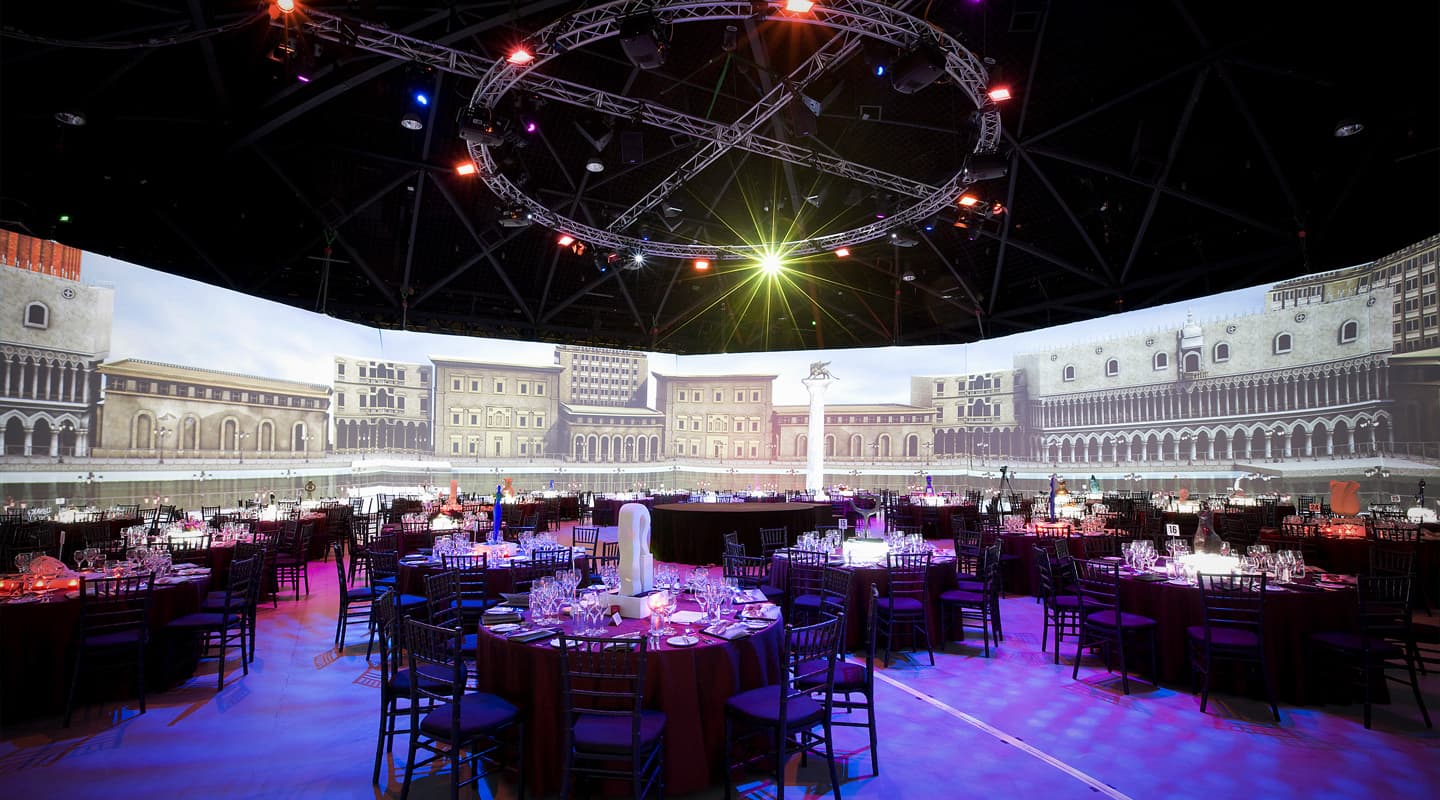
We’ve Got You Surrounded
G1 Productions is creating immersive environments with seamless 360° projection.
Text: / Tim Stackpool
Photos: / G1 Productions
With the demands on audio visual producers to stretch their imagination to more innovative ideas, Ian Andrew Walsh and his company G1 Productions have carved out a niche delivering a projected environment that surrounds and immerses an audience. Loosely dubbed 360° projection, the system, as the name suggests, uses multiple surfaces and multiple projectors with image-combining technology to complete the seamless picture.
“When we talk about 360° projection, we’re referring to projecting on all sides so as to be surrounded by projection,” explains Ian Andrew Walsh. “In the past we have done this in a rectangle or octagon format. We are yet to do a true circular screen, as this would be quite expensive. Besides, we find that the octagonal format gives the illusion of a circle.” The images fed to each of the projectors are blended using the industry recognised Watchout system from Dataton. To date, G1 has completed projects with as many as 10 projectors, but they are currently in the planning stages of a job using as many as 12 projectors.
Walsh believes the successful use of the technology can be measured by how you integrate the theme into the presentation. He cites this example: “On a recent charity event, themed as a Venetian Masquerade, we created a storybook feel in which the guests appeared as characters on the pages. Each step through the night was both read aloud from a story book and graphically written onto the book which was 6m high and 12m wide. The pages graphically unfolded that chapter all around the guests and they became part of the story.”
RESOLUTION REALLY MATTERS
With all projection systems, the challenge of sufficient resolution comes into play, more so when the imagery is surrounding the audience. For this reason Walsh often insists on originating the content in-house. “We generally end up creating content from scratch and have to come up with creative ways of using media. If you can imagine, when you’re creating content for a room that is 128 metres around and eight metres high, your ratios are pretty extreme. One of the hardest challenges is ensuring the attention to detail, especially when you build the content from scratch in 3D and then export to video. But we are very conscious of this.”
This leads to the age-old question of having enough computer processing power to both manage and complete the job in a timely manner. “Other challenges include the rendering time required, and particularly ensuring you have not made your content too elaborate,” Walsh said. “A good render farm is essential. In addition, all the files need to be sliced up and then overlaid for each projector, so you’re constantly double and triple handling.”
File size is also important. “We use Watchout, and this is a fantastic system to work with. However, like any type of design work, you need to ensure your media is driven by gutsy machines, as such, excellent servers are required,” Walsh said.
Due to the size of these productions (4,000 – 14,000 pixels wide) much of the image creation is undertaken in packages such as Photoshop, Maya and Cinema 4D. Following that, the content is composited with lower resolution footage (on this scale, even HD footage at 1920 x 1080 is considered low res), then the entire imagery is exported via After Effects. “It’s possible to scale moving content a little bit, maybe 130% but beyond that you start to see artefacts and loss of quality,” Walsh said.
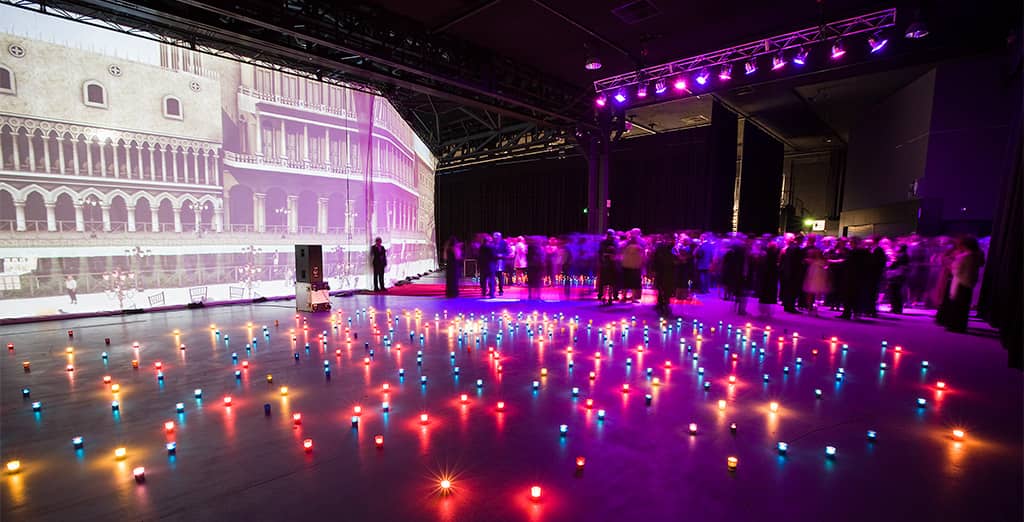
Even the outside is impressive: Guests arrive for a Venetian masquerade-themed charity dinner.
REAL TIME VS RENDERED
Another consideration is determining a balance between the content rendered via After Effects, and other material that can merely be played-out using the real-time capabilities of Watchout. Walsh notes: “Some producers use Watchout purely as a movie replay device, without considering how to utilise all of its features to save production and rendering. In our case, once the creative is complete, we often sit down with our Watchout programmer, Mal Padgett, to work out the best way to create the content.
“Sometimes we use large-format ‘still’ or non-moving artwork as a backdrop, separate elements such as text, stills and standard resolution videos, then use the positioning, scaling, rotation and opacity tools in Watchout to create large-scale content. This can all be seamlessly blended with our large movies so the audience isn’t aware of whether they’re experiencing an After Effects movie or Watchout programming. Making components also allows for last minute changes when they’re required. If you render it all as movies then it can limit your creative options at the end, and sometimes it is only once you see the show set up in its entirety that you can fully appreciate the overall effect.
“”
It’s a buzz when you see people standing up in the audience and taking snaps of the screens!
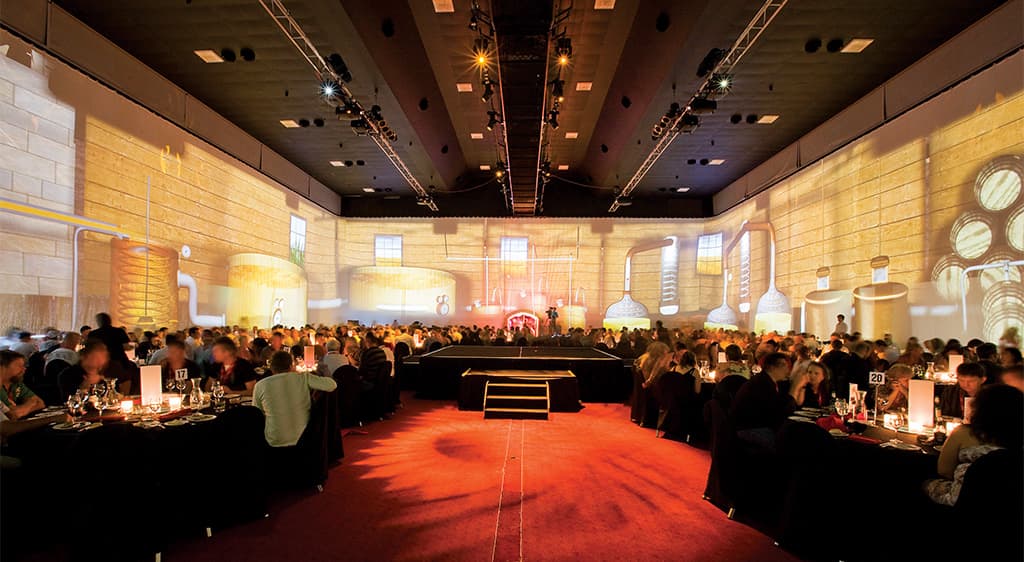
Diners immersed in a stylised distillery for a beverage promotion.
WATCHOUT – SWEDISH ARMY KNIFE
In addition to being a projection blending tool, Watchout is also a compositor of still and moving media, so it stands apart from other replay devices such as Spyder, systems like Catalyst or software such as Keynote and Arkaos. “In many ways, Watchout cuts across all these products and can also be used as a kind of digital glue to make best use of all of them. If you look at it like a Venn diagram, Watchout would overlap with all of the previously mentioned hardware and software,” said Walsh. “It’s important to understand the differences and strengths and weaknesses of all systems, consider your budget, then plan your media and staging setup accordingly.”
For Walsh, one key to spectacular large-screen productions is having pixel-mapped content. That is, for every pixel on the screen, content is produced to match it. “If we are going to the effort and expense of building a spectacular rig that has up to 14,000 pixels of resolution, it makes sense to make use of that potential. The extra effort in creating pixel-mapped content is definitely a big part of the ‘Wow’ factor with the audience. It’s a buzz when you see people standing up in the audience and taking snaps of the screens!”
At the core of any great AV technology, generally lays the intelligence and power contained within the humble PC. “The greatest advances have come with inexpensive, fast computers,” Walsh admits. “The latest dual- or quad-core processors, faster motherboards, fast hard drives and graphic cards, cut through media like a hot knife through butter. Of course with Watchout, Mike Fahl, the creator and chief programmer of Watchout at Dataton in Sweden, is constantly improving it – I think it has something to do with the long winters up there. Version 4 has some neat tricks, such as using DMX in/out and MIDI as triggers, multiple timelines and some other improvements that make programming faster and easier. Version 1 of Watchout back in 2000 didn’t even have Undo, so it has certainly come a long, long way!”
One of the challenges with using so many different types of media, comes not from the hardware, but from the data streams themselves. “The only real annoyance is getting the DVI outputs talking to video and projector gear as easily as RGB connections do. If the consortiums behind the DVI standard could get together and work on a more plug and play compatibility between graphic cards, switchers and projectors it would be a big step forward,” Walsh commented.
TEAMWORK TELLS
As with all production, there remains an emphasis on teamwork, and in the quality of the technology employed. Walsh is particularly loyal when it comes to his support crew.
“Being producers of both the event and content, we’re not wanting to just create a backdrop, but rather a motion backdrop. Our events wouldn’t be what they are if it weren’t for the high-quality projectors we use from the Technical Direction Company (TDC). Their technicians are highly skilled and down to earth people, and this makes a world of difference,” he praised. In general, Walsh chooses to use Barco SLM R12 or FLM R20 series projectors. “Our multimedia is only part of the equation. We then need to have this content programmed into Watchout. This almost feels like starting again from scratch: storyboards need to be created, files labelled correctly to ensure that they’re cut up as required for each projector in each scene. Our in-house design team take care of that. Then Mal Padgett is called in to complete the programming. Mal’s knowledge and understanding of Watchout is exceptional and I would not work with anyone else. Together we push the boundaries.”
This teamwork is paramount to G1’s success. A typical event, using imagery 14,000 pixels wide by 1050 pixels tall in itself can take as many as six designers more than two months to complete and finally render the imagery. Even still, the event may require the inclusion of material shot and acquired from the days immediately preceding the event, and sometimes from the day of presentation itself. Being surrounded by this support makes Walsh confident of maintaining the market’s demand for further developments in this immersive technology.



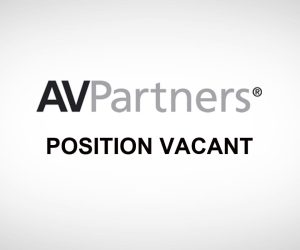

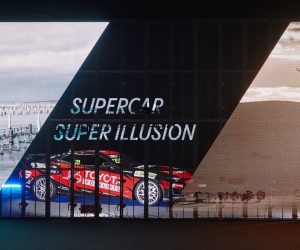
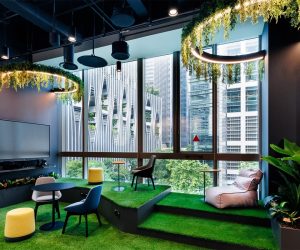
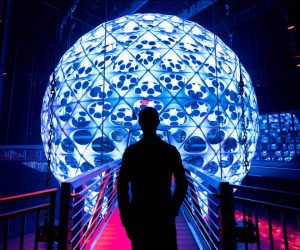
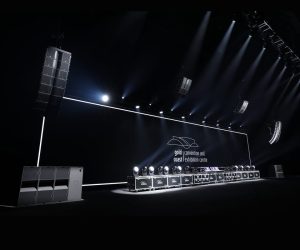
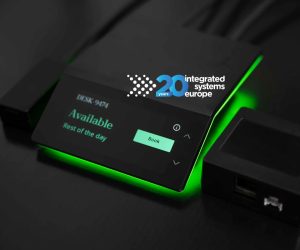


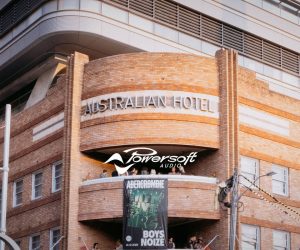

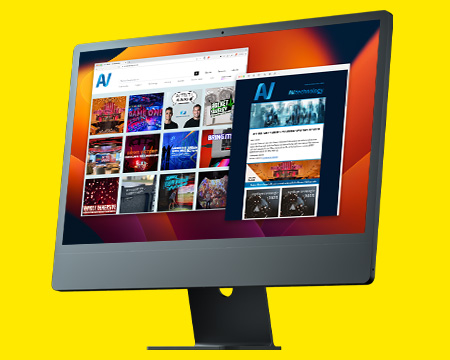
RESPONSES